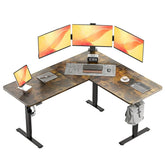Elevate Your Studio: Real Music Producers Share How Standing Desks Transformed Their Workflow
You've been in the game for a while. You understand the late nights, the intricate sound design, the endless pursuit of the perfect mix. Your studio is your sanctuary, a space crafted for creativity. But if you're like many music producers, you've also experienced the physical toll that comes with the territory – the persistent backaches, the nagging neck pain, the fatigue that creeps in just when inspiration strikes.
Perhaps you've considered making a change, exploring ways to optimize your workspace for both comfort and productivity. The concept of a standing desk has likely crossed your radar. It's not just a trend; it's a growing movement among creative professionals seeking a more dynamic and healthier way to work.
But you're discerning. You need to know how this applies to your world, the nuanced environment of music production. Generic office solutions might not cut it. That's why we've connected with fellow music producers – individuals deeply immersed in the craft – to share their experiences and insights on how incorporating a standing desk has genuinely impacted their studios and their creative process. Their firsthand accounts offer a practical perspective on whether this upgrade could be the key to unlocking new levels of comfort, focus, and ultimately, better music.
Beyond Comfort: Tangible Benefits Real Producers Are Experiencing
The producers we spoke with consistently highlighted benefits that go beyond simply alleviating physical discomfort. Here’s what they shared:
A Fresh Sonic Perspective:
Several producers noted that the simple act of standing provides a different spatial relationship with their monitors. "When I stand back a bit, I hear my mix in a new way," says Sarah, an electronic music producer. "It helps me identify imbalances or frequencies that weren't as apparent when I was always locked into the same seated position." This shift in perspective can lead to more informed mixing decisions and a more polished final product.
Sustained Energy and Focus:
The demands of music production often require long, uninterrupted stretches of focused work. Many producers found that the option to stand helped combat the afternoon slump or the late-night fatigue. "I used to hit a wall after a few hours of sitting," explains Mark, a hip-hop beatmaker. "Now, when I feel my energy dipping, I raise my desk and keep going. It’s like a reset button without having to step away from my project." This sustained energy can translate directly into more productive and creative sessions.

Enhanced Physical Connection to Music:
Music, at its core, is often a physical experience. Whether you're tapping out rhythms or gesturing while arranging tracks, movement can be integral to the creative process. "I find I'm more physically engaged with the music when I'm standing," shares Ben, a film composer who often conducts virtual instruments. "It feels more natural, almost like performing." A standing desk allows for this subtle but significant physical engagement, potentially fostering a deeper connection to your creations.
Seamless Workflow Integration:
The fear of disrupting an established workflow is understandable. However, producers who’ve made the switch emphasize the adaptability of a quality standing desk. "I can transition from intricate editing while seated to more expressive work standing up in seconds," notes Lisa, a sound designer. "The ability to move between postures without breaking my concentration is crucial." Features like programmable height presets make these transitions effortless.
A Healthier Foundation for a Long Career:
While the immediate benefits to workflow and creativity are compelling, many producers also acknowledged the long-term health advantages. Reducing prolonged sitting can contribute to better posture, improved circulation, and a decrease in the risk of various health issues. "I realized I needed to invest in my physical well-being to sustain my passion for music over the long haul," says Tom, a veteran mixing engineer. "The standing desk is a key part of that investment."
Addressing Your Concerns: Practical Insights from the Field
Understandably, you might have some reservations. Here’s how our fellow producers addressed common concerns:
-
Precision Work: "I was worried about losing precision for detailed editing," admits Sarah. "But the truth is, I simply lower my desk when I need that focused control. The flexibility is the key."
-
Studio Space Constraints: "My studio isn't huge," says Mark. "But there are standing desk designs that fit even smaller spaces. Look for ones with a manageable footprint and consider wall-mounted accessories to maximize desk surface."
-
Cost Justification: "It felt like a significant investment initially," reflects Lisa. "But when I factored in the increased productivity, reduced discomfort, and potential long-term health benefits, it became clear that it was a worthwhile upgrade for my business and my well-being."
Making the Informed Choice: What resonates with you?
Hearing from peers who have already integrated standing desks into their music production workflows offers valuable perspective. Their experiences highlight that this isn't just about following a trend; it's about making a conscious choice to optimize your studio for enhanced creativity, sustained focus, and long-term well-being.
Consider what aspects of their experiences resonate most with your own challenges and aspirations. Are you seeking a new sonic perspective on your mixes? Do you need more energy to power through those demanding sessions? Are you looking for a way to foster a more dynamic and physically engaged creative process?
Investing in your studio is an investment in your craft. By learning from the experiences of other music producers, you can make a more informed decision about whether a standing desk is the right tool to elevate your workspace and your music.
Ready to explore standing desk options that are helping music producers like you transform their studios?



